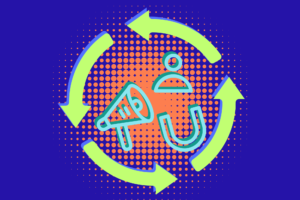Table of Contents
Last Updated on January 25, 2024 by admin
This post was originally published in May 2020 but is being updated in January 2024 because email marketing for fintechs is always evolving. Enjoy the updated guidance on using email marketing to grow your business.
When this article was originally published, COVID was negatively impacting many companies. But it also highlighted the necessity of fintechs and the services they provide. While we’re no longer operating under the same uncertainty as we were during the pandemic, the trend towards all things remote (working, shopping, communicating, etc.) went a long way in highlighting some behavioral changes that would stick around long after the pandemic was in our rearview mirror.
One of the major trends that emerged during the pandemic was the adoption of mobile finance apps, which benefitted fintechs. Digital mortgage software provider Blend, for example, saw refinance applications through the Blend platform up by 1500% to 2000% in Q1 of 2020 as compared to the same period in 2019. The company experienced between 15,000 and 20,000 applications per day.
In sum, of the many behavioral trends that emerged during the pandemic, the adoption of digital platforms, services, and tools dominated. And these trends and behaviors have not necessarily dissipated to pre-pandemic levels. People are leveraging digital tools more than ever. Marketing is no exception.
It’s important to understand how to foster connection, empathy, and engagement through digital channels. Technology that enables digital connection is not an excuse to miss out on true relationship building. Rather, it should facilitate more of it.
Email Marketing for Fintechs is a Must
Email marketing for fintechs is not new, though it is often overlooked as a valid way to drive business growth. Some organizations leverage e-newsletters, which can be a great way to engage with your audience. But the possibilities are endless. It’s also easy to grow comfortable with familiar fintech marketing tactics, which can lead to stale outreach and lost connections with prospects and customers. Now is the time to revisit email marketing and refresh campaigns and strategies to meet the current needs of your audience.
If you’re looking for ways to spice up email (or any of your other fintech marketing tactics), ask yourself the following questions:
- Who is our audience and what is important to them today?
- Is our audience made up of segments? How can we better define our audience to offer a more personalized experience?
- How clean is our CRM data?
- Are we able to leverage partnerships and/or tap into second-party data?
- Is our messaging updated and accurate given the current landscape?
The more specifically you can answer those questions, the better you’ll be able to tailor your email marketing program for your target audience.
Personalization is the Magic Maker in Email Marketing for Fintechs
It’s not a new directive, but personalization is everything. Customers have come to expect it and businesses that can deliver it enjoy increased revenues, increased loyalty, and increased ROI:
- 80% of companies report seeing an uplift since implementing personalization. – Econsultancy
- Marketers report that personalization efforts can boost revenues by up to 15%. – Adweek
- 86% of marketers have seen a measurable lift in business results from their personalization campaigns. – Evergage
- 95% of companies that saw 3x ROI from their personalization efforts increased profitability in the year after their personalization efforts. – Monetate
- Personalization can reduce customer acquisition costs by up to 50%. – Adweek
There are a variety of ways to personalize email marketing for fintechs. Take a look at some of the following ways to personalize email campaigns.
Past Engagement
Take a page from Amazon’s book and personalize email campaigns based on past engagement. Gather insights from data to see where customers interacted with your brand previously and send personalized emails based on that information. That may include customized discounts or offers or information tailored to their interests.
Location-Based Personalization
Tapping location information can aid in personalizing messages and offers for customers and prospects. This should only be used where relevant, but if you provide services that may be useful to businesses in a state that has specific legal or compliance requirements, for example, this can be a great tactic to use.
Interest-Based Personalization
Using personal information and insights about what customers are interested in is a great way to tailor email marketing for fintechs. Sending curated offers or information is an effective way to engage your audience and show them that you’re paying attention.
Best Practices for Email Marketing for Fintechs
- Segment, segment, segment — This requires a deep understanding of who your prospects are and where they are in the buyer’s journey. With this data, you can segment contacts by lifecycle stage and persona. This goes a long way in developing personalized messaging that makes an impact.
- Keep your data clean — Practice good list hygiene, eliminate duplicate data and data systems, and make sure to follow unsubscribe best practices. Contrary to what your gut might tell you, unsubs aren’t bad. They keep your list focused on people interested in the value you add. If you do find that your unsub rate is high, review the content you’re sending (and the frequency) to ensure that you are, in fact, adding value to people’s lives.
- Don’t forget emotional appeal — It’s easy to stick to “business as usual” when sending emails, but don’t be afraid to inject a little emotional appeal into your emails. They are, after all, coming from a human. This goes hand-in-hand with personalization; your email recipients should feel like they are receiving a personal touch — not a mass email targeting thousands of people.
- Maintain email sender reputation — Too much cold emailing can lead to trouble when it comes to sender reputation. Fintech is an industry dependent on trust-building, so focus on adding value and strengthening credibility. If you’re planning to send an email, ask yourself if it does either of those things before you launch. Too many spam reports could damage your deliverability.
- Have a strategy — Email marketing for fintechs should not consist of shooting blindly into the wind. Understand what your overarching goals are and map backward from there to understand which email marketing KPIs are most important. Use that data to create campaigns that will resonate with your target audience, which is ultimately more important than hitting numbers.
Email marketing for fintechs continues to be a proven tactic for engaging with prospects and growing the business. Personalizing campaigns can make your marketing dollars go even further. Remember, personalization means much more than adding in a person’s first name in a subject line; it’s about garnering helpful insights from the data on hand to better serve your prospects and customers.
Get More Tips on Email Marketing for Fintechs With These Playbooks
Looking for more fintech marketing tactics, tools, and content? Check out one of our helpful playbooks and guides:
- Fintech Demand Generation Playbook
- Fintech Customer Acquisition Playbook
- B2B Fintech Lead Generation & Marketing During a Recession
- Fintech Marketing Playbook
- Payments Thought Leadership Playbook
- The Financial Marketer’s Guide to Content Marketing



